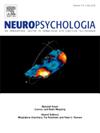Distribution of attention in three-dimensional space
IF 2
3区 心理学
Q3 BEHAVIORAL SCIENCES
引用次数: 0
Abstract
The distribution of spatial attention has mostly been studied for visual events presented within a two-dimensional space. In this study, we examined the distribution of spatial attention in a three-dimensional space (i.e., across the z-axis). Much previous research suggests that attention is universally biased toward stimuli appearing in near space compared to far space. However, the results of some studies suggest this ‘near advantage’ is task-specific, with some tasks instead producing an attention bias toward stimuli in far space. The current study investigated whether two tasks that differ in attentional priorities (i.e., target localization vs target discrimination) differentially bias attention across near and far depth. Across three experiments, we compared target localization and target discrimination tasks when a single target appeared as the stimulus (Experiment 1) and then, for a cue-target task, compared target localization (Experiment 2A) and target discrimination tasks (Experiment 2B). Our results support the proposal that the near advantage is task-specific. For target localization, reaction times (RTs) were shorter for near-targets than for far-targets, however, for target discrimination, RTs were shorter for far-targets than for near-targets. This result was revealed in both uncued and cue-target paradigms. The cue-target paradigm also showed that relative to same-depth conditions, the cueing effect pointed to greater facilitation when orienting attention from far-to-near space for target localization but from near-to-far space for target discrimination. These findings argue against a universal near advantage. Overall, the results were consistent with the notion that different task demands can differentially bias the distribution of attention across near and far depth, a proposal that has implications for the potential involvement of the dorsal and ventral visual processing streams.
注意力在三维空间中的分布
空间注意力的分布主要是针对二维空间中呈现的视觉事件进行研究的。在本研究中,我们考察了空间注意力在三维空间(即横跨 Z 轴)中的分布情况。以往的许多研究表明,与远距离空间相比,注意力普遍偏向于出现在近距离空间的刺激物。然而,一些研究结果表明,这种 "近距离优势 "是针对特定任务的,有些任务反而会产生对远距离刺激物的注意偏向。本研究调查了两种注意力优先级不同的任务(即目标定位与目标辨别)是否会在近距离和远距离深度上产生不同的注意力偏差。在三个实验中,我们比较了单个目标作为刺激物出现时的目标定位和目标辨别任务(实验 1),然后在提示目标任务中比较了目标定位(实验 2A)和目标辨别任务(实验 2B)。我们的结果支持了近距离优势具有任务特异性的观点。在目标定位任务中,近目标的反应时间(RTs)比远目标短;而在目标辨别任务中,远目标的反应时间比近目标短。这一结果在无提示和提示-目标范式中都得到了证实。提示-目标范式还显示,相对于相同深度条件,提示效应表明,在目标定位时,将注意力从远至近的空间导向目标,而在目标辨别时,将注意力从近至远的空间导向目标,会有更大的促进作用。这些发现反驳了普遍的近距离优势。总之,这些结果与不同的任务要求会使注意力在近深和远深之间的分布产生不同偏差的观点是一致的,这一提议对背侧和腹侧视觉处理流的潜在参与具有影响。
本文章由计算机程序翻译,如有差异,请以英文原文为准。
求助全文
约1分钟内获得全文
求助全文
来源期刊

Neuropsychologia
医学-行为科学
CiteScore
5.10
自引率
3.80%
发文量
228
审稿时长
4 months
期刊介绍:
Neuropsychologia is an international interdisciplinary journal devoted to experimental and theoretical contributions that advance understanding of human cognition and behavior from a neuroscience perspective. The journal will consider for publication studies that link brain function with cognitive processes, including attention and awareness, action and motor control, executive functions and cognitive control, memory, language, and emotion and social cognition.
 求助内容:
求助内容: 应助结果提醒方式:
应助结果提醒方式:


